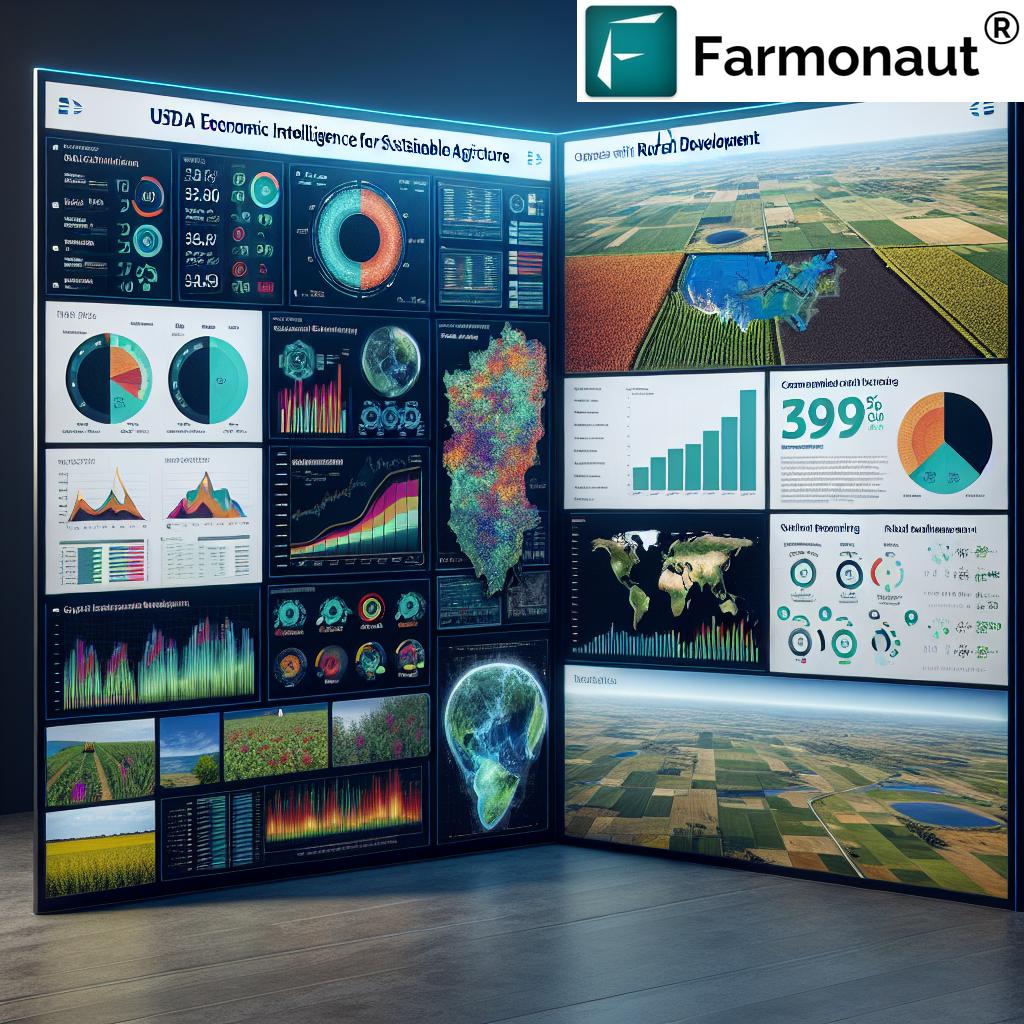Unlocking Agricultural Economic Trends: USDA’s Comprehensive Analysis Shapes U.S. Rural Policy and Food Security

“The USDA’s Office of the Chief Economist analyzes over 100 agricultural commodities to inform critical policy decisions.”
In the ever-evolving landscape of United States agriculture, economic analysis plays a pivotal role in shaping rural policies and ensuring food security. As we delve into the intricate world of agricultural economics, we’ll explore how the USDA’s comprehensive studies are influencing the nation’s food and fiber system. This blog post will uncover the latest agricultural market trends, sustainable farming practices, and the impact of climate change on our vital agricultural sector.
The USDA’s Office of the Chief Economist: Guiding Agricultural Policy
At the heart of the United States’ agricultural economic analysis is the USDA’s Office of the Chief Economist (OCE). This critical department serves as the nexus for data-driven decision-making in the agricultural sector. By conducting in-depth research and producing detailed reports, the OCE provides invaluable insights that shape rural development policies and food security solutions.
- Market Analysis: The OCE constantly monitors agricultural market trends, offering real-time data on commodity prices and trade dynamics.
- Policy Research: Through rigorous agricultural policy research, the office evaluates the potential impact of new legislation on farmers and rural communities.
- Risk Assessment: Comprehensive risk assessment tools help policymakers and farmers navigate the uncertainties inherent in agriculture.
The OCE’s work is fundamental in addressing the complex challenges facing modern agriculture, from climate change to evolving consumer preferences.
Agricultural Market Trends: A Dynamic Landscape
Understanding agricultural market trends is crucial for stakeholders across the food and fiber system. We’ve observed several key trends shaping the industry:
- Sustainable Agriculture: There’s a growing emphasis on sustainable farming practices, driven by consumer demand and environmental concerns.
- Digital Agriculture: The adoption of precision agriculture technology is revolutionizing farm management and crop yield optimization.
- Diversification: Farmers are increasingly diversifying their crops and income streams to mitigate risks associated with market volatility.
- Global Trade Shifts: International trade policies and agreements continue to impact commodity markets and export opportunities.
These trends underscore the need for adaptive strategies and informed decision-making in the agricultural sector.
Climate Change and Agriculture: Adapting to New Realities
The impact of climate change on agriculture cannot be overstated. As weather patterns become increasingly unpredictable, farmers and policymakers must adapt to ensure continued food security and economic stability in rural areas.
- Drought Resistance: Development of drought-resistant crops through biotechnology and traditional breeding methods.
- Water Management: Implementation of advanced irrigation systems and water conservation techniques.
- Pest Management: Evolving strategies to combat new and migrating pests and diseases.
- Carbon Sequestration: Exploration of agricultural practices that can help mitigate climate change by sequestering carbon in soil.
The USDA’s climate solutions initiatives are at the forefront of helping the agricultural sector adapt to and mitigate the effects of climate change.
Explore Farmonaut’s innovative solutions for climate-smart agriculture: 
Precision Agriculture: Revolutionizing Farm Management
“Precision agriculture technology has increased crop yields by up to 30% while reducing water usage by 20-50%.”
Precision agriculture technology is transforming the way farms operate, offering unprecedented levels of control and efficiency. By leveraging data-driven insights, farmers can optimize their resource use and maximize crop yields.
- Satellite Imagery: Real-time monitoring of crop health and soil conditions.
- IoT Sensors: Collection of granular data on moisture levels, nutrient content, and pest presence.
- AI-powered Analytics: Advanced algorithms providing actionable insights for farm management decisions.
- Automated Machinery: GPS-guided equipment reducing labor costs and improving accuracy in planting and harvesting.
The integration of these technologies is not only boosting productivity but also contributing to more sustainable farming practices.
Discover how Farmonaut’s precision agriculture tools can revolutionize your farming operations: 

Rural Development Policies: Strengthening America’s Heartland
Rural development policies are essential for maintaining the vitality of America’s agricultural communities. The USDA’s initiatives focus on several key areas:
- Infrastructure Investment: Improving roads, bridges, and broadband access in rural areas.
- Economic Diversification: Supporting the growth of non-agricultural businesses in rural communities.
- Education and Training: Providing resources for skill development and agricultural education.
- Healthcare Access: Expanding telemedicine and rural health clinics to improve quality of life.
These policies aim to create resilient rural economies that can withstand agricultural market fluctuations and provide sustainable livelihoods for rural residents.
Food Security Solutions: Ensuring Access for All
Food security remains a critical concern, even in a nation as agriculturally productive as the United States. The USDA’s economic analysis informs various programs and initiatives designed to address this issue:
- Supplemental Nutrition Assistance Program (SNAP): Providing food assistance to low-income individuals and families.
- Farm to School Programs: Connecting local farmers with school cafeterias to improve student nutrition.
- Community Food Projects: Supporting local efforts to increase food security and promote self-reliance.
- Emergency Food Assistance: Ensuring food availability during natural disasters and economic crises.
These programs, guided by rigorous economic analysis, play a crucial role in maintaining the nation’s food security infrastructure.
Agricultural Policy Research: Informing Future Decisions
Ongoing agricultural policy research is vital for addressing emerging challenges and opportunities in the sector. Key areas of focus include:
- Trade Policy: Analyzing the impacts of international agreements on U.S. agriculture.
- Farm Bill Analysis: Evaluating the effectiveness of current farm programs and proposing improvements.
- Labor Market Dynamics: Studying the changing workforce needs in agriculture and rural communities.
- Environmental Regulations: Assessing the economic implications of conservation and environmental policies.
This research provides the foundation for evidence-based policymaking, ensuring that agricultural policies are responsive to the needs of farmers, rural communities, and consumers.

Crop Yield Optimization: Maximizing Agricultural Output
Improving crop yields is a constant focus of agricultural research and policy. The USDA’s efforts in this area include:
- Genetic Research: Developing crop varieties with improved yield potential and resistance to pests and diseases.
- Soil Health Initiatives: Promoting practices that enhance soil fertility and structure.
- Precision Agriculture Adoption: Encouraging the use of technology for targeted resource application.
- Climate-Resilient Farming: Researching and promoting farming methods that can withstand changing climate conditions.
These initiatives aim to increase agricultural productivity while maintaining sustainability and economic viability for farmers.
Optimize your crop yields with Farmonaut’s advanced satellite monitoring: Explore our API
Farm Management Software: Empowering Data-Driven Agriculture
The rise of farm management software has revolutionized agricultural operations. These digital tools offer numerous benefits:
- Resource Tracking: Monitoring inputs such as water, fertilizer, and pesticides for optimal usage.
- Financial Management: Streamlining accounting and budgeting processes for improved profitability.
- Yield Forecasting: Utilizing historical data and current conditions to predict crop yields.
- Compliance Management: Ensuring adherence to regulatory requirements and certification standards.
By leveraging these technologies, farmers can make more informed decisions and improve their overall operational efficiency.
Economic Analysis in Action: A Case Study of the U.S. Corn Industry
To illustrate the impact of economic analysis on agricultural policy, let’s examine the U.S. corn industry:
- Market Dynamics: USDA reports on corn production and demand influence planting decisions and market prices.
- Ethanol Policy: Economic analysis of the Renewable Fuel Standard has shaped policies affecting corn-based ethanol production.
- Trade Relations: Studies on international corn markets inform trade negotiations and export strategies.
- Climate Adaptation: Research on climate impacts guides the development of resilient corn varieties and farming practices.
This case study demonstrates how comprehensive economic analysis translates into tangible policy outcomes and market impacts.
The Role of Technology in Agricultural Economic Analysis
Advanced technologies are enhancing the depth and accuracy of agricultural economic analysis:
- Big Data Analytics: Processing vast amounts of agricultural data to identify trends and patterns.
- Machine Learning: Developing predictive models for crop yields, market prices, and climate impacts.
- Blockchain: Improving traceability in agricultural supply chains and enhancing market transparency.
- Remote Sensing: Using satellite and drone imagery to assess crop conditions and land use changes.
These technological advancements are providing unprecedented insights into agricultural systems, enabling more precise and timely economic analysis.
Leverage cutting-edge technology for your agricultural operations: Access Farmonaut’s API Developer Docs
Sustainable Farming Practices: Balancing Productivity and Conservation
Economic analysis plays a crucial role in promoting sustainable farming practices that balance productivity with environmental conservation:
- Conservation Tillage: Assessing the economic benefits of reduced tillage practices.
- Cover Crops: Analyzing the long-term economic impacts of soil health improvement through cover cropping.
- Integrated Pest Management: Evaluating the cost-effectiveness of alternative pest control strategies.
- Precision Nutrient Management: Calculating the optimal application of fertilizers for maximum efficiency and minimal environmental impact.
These practices not only contribute to environmental sustainability but also often lead to improved long-term economic outcomes for farmers.
The Future of Agricultural Economics: Emerging Trends and Challenges
As we look to the future, several key trends and challenges are shaping the field of agricultural economics:
- Global Food Demand: Analyzing strategies to meet the nutritional needs of a growing world population.
- Technological Disruption: Assessing the economic implications of emerging technologies like vertical farming and lab-grown meat.
- Climate Resilience: Developing economic models to support climate-adaptive agricultural systems.
- Rural-Urban Dynamics: Studying the changing relationships between rural and urban economies in the food system.
Addressing these challenges will require innovative approaches to economic analysis and policy development.
Economic Impact of Agricultural Policies
| Policy Name | Implementation Year | Target Sector | Economic Impact ($B) | Rural Development Score |
|---|---|---|---|---|
| 2018 Farm Bill | 2018 | Multiple | 428 | 8 |
| Federal Crop Insurance Program | 1938 (Major reforms in 2014) | Crop Producers | 8 (Annual average) | 7 |
| USMCA Trade Agreement | 2020 | Multiple | 65 (Projected) | 6 |
| Conservation Reserve Program | 1985 | Land Conservation | 1.8 (Annual) | 9 |
| Renewable Fuel Standard | 2005 (Expanded in 2007) | Biofuels | 30 (Estimated annual impact) | 7 |
Conclusion: The Vital Role of Economic Analysis in Shaping Agricultural Policy
As we’ve explored throughout this blog post, economic analysis serves as the foundation for informed decision-making in the agricultural sector. From shaping rural development policies to addressing food security challenges, the insights provided by the USDA’s Office of the Chief Economist and other research institutions are invaluable.
The integration of advanced technologies, sustainable farming practices, and data-driven management tools is transforming the agricultural landscape. As we face the challenges of climate change, population growth, and evolving consumer preferences, the role of comprehensive economic analysis in guiding agricultural policy will only grow in importance.
By continuing to invest in agricultural economic research and fostering collaboration between policymakers, farmers, and researchers, we can build a more resilient, sustainable, and prosperous agricultural future for the United States and beyond.
FAQ Section
Q: What is the role of the USDA’s Office of the Chief Economist?
A: The Office of the Chief Economist conducts comprehensive economic analysis of agricultural markets, policies, and trends to inform decision-making and policy development in the U.S. agricultural sector.
Q: How does precision agriculture technology impact farm productivity?
A: Precision agriculture technology can increase crop yields by up to 30% while reducing water usage by 20-50% through optimized resource management and data-driven decision-making.
Q: What are some key challenges facing U.S. agriculture today?
A: Major challenges include climate change impacts, market volatility, labor shortages, and the need for sustainable intensification to meet growing global food demand.
Q: How do rural development policies contribute to agricultural economics?
A: Rural development policies aim to strengthen rural economies by improving infrastructure, supporting economic diversification, and enhancing quality of life, which in turn supports a robust agricultural sector.
Q: What role does technology play in modern agricultural economic analysis?
A: Technology, including big data analytics, machine learning, and remote sensing, enhances the accuracy and depth of agricultural economic analysis, enabling more precise forecasting and policy recommendations.



